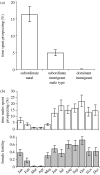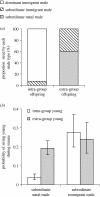Subordinate male meerkats prospect for extra-group paternity: alternative reproductive tactics in a cooperative mammal - PubMed (original) (raw)
Comparative Study
Subordinate male meerkats prospect for extra-group paternity: alternative reproductive tactics in a cooperative mammal
Andrew J Young et al. Proc Biol Sci. 2007.
Abstract
In cooperatively breeding species, subordinates typically suffer strong constraints on within-group reproduction. While numerous studies have highlighted the additional fitness benefits that subordinates might accrue through helping, few have considered the possibility that subordinates may also seek extra-group matings to improve their chances of actually breeding. Here, we show that subordinate males in cooperative meerkat, Suricata suricatta, societies conduct frequent extraterritorial forays, during periods of peak female fertility, which give rise to matings with females in other groups. Genetic analyses reveal that extra-group paternity (EGP) accrued while prospecting contributes substantially to the reproductive success of subordinates: yielding the majority of their offspring (approx. 70%); significantly reducing their age at first reproduction and allowing them to breed without dispersing. We estimate that prospecting subordinates sire 20-25% of all young in the population. While recent studies on cooperative birds indicate that dominant males accrue the majority of EGP, our findings reveal that EGP can also arise from alternative reproductive tactics employed exclusively by subordinates. It is important, therefore, that future attempts to estimate the fitness of subordinate males in animal societies quantify the distribution of extra-group as well as within-group paternity, because a substantial proportion of the reproductive success of subordinates may otherwise go undetected.
Figures
Figure 1
(a) The proportion of time spent by males prospecting in different dominance and dispersal classes. Bars present predicted means±s.e. from the GLMM, controlling for seasonal variables and males prospecting at higher rates as they age (see §3). (b) The seasonal variation in male prospecting closely paralleled that of female fertility. The prospecting profile presents predicted monthly means±s.e. for subordinate natal males (calculated by substituting calendar month in place of the female fertility variable in our prospecting-time GLMM; the profile for subordinate immigrant males was almost identical, just with lower values). The female fertility bars present monthly means±s.e. of dominant female conception probabilities, calculated from our historical data (see §2).
Figure 2
(a) The distribution of intra- and EGP among males of differing dominance and dispersal class (for the 51 offspring that were assigned fathers with greater than 95% confidence: 41 intra-group sirings and 10 extra-group sirings). (b) The probability that subordinate males sired intra- or extra-group offspring before and after dispersal from their natal groups. Bars represent predicted means±s.e. from the GLMM (using 279 offspring assigned with greater than 80% confidence), controlling for variation in each male's tenure in that dispersal class.
Similar articles
- Infanticide by subordinates influences reproductive sharing in cooperatively breeding meerkats.
Young AJ, Clutton-Brock T. Young AJ, et al. Biol Lett. 2006 Sep 22;2(3):385-7. doi: 10.1098/rsbl.2006.0463. Biol Lett. 2006. PMID: 17148410 Free PMC article. - Adaptive suppression of subordinate reproduction in cooperative mammals.
Clutton-Brock TH, Hodge SJ, Flower TP, Spong G, Young A. Clutton-Brock TH, et al. Am Nat. 2010 Nov;176(5):664-73. doi: 10.1086/656492. Am Nat. 2010. PMID: 20846043 - The number of subordinates moderates intrasexual competition among males in cooperatively breeding meerkats.
Kutsukake N, Clutton-Brock TH. Kutsukake N, et al. Proc Biol Sci. 2008 Jan 22;275(1631):209-16. doi: 10.1098/rspb.2007.1311. Proc Biol Sci. 2008. PMID: 17986431 Free PMC article. - Meerkat manners: Endocrine mediation of female dominance and reproductive control in a cooperative breeder.
Drea CM, Davies CS. Drea CM, et al. Horm Behav. 2022 Sep;145:105245. doi: 10.1016/j.yhbeh.2022.105245. Epub 2022 Aug 18. Horm Behav. 2022. PMID: 35988450 Review. - Adaptations to subordinate status in female marmoset monkeys.
Abbott DH, Saltzman W, Schultz-Darken NJ, Tannenbaum PL. Abbott DH, et al. Comp Biochem Physiol C Pharmacol Toxicol Endocrinol. 1998 Jun;119(3):261-74. doi: 10.1016/s0742-8413(98)00015-2. Comp Biochem Physiol C Pharmacol Toxicol Endocrinol. 1998. PMID: 9826999 Review.
Cited by
- Evolution of sex differences in cooperation can be explained by trade-offs with dispersal.
Capilla-Lasheras P, Bircher N, Brown AM, Harrison X, Reed T, York JE, Cram DL, Rutz C, Walker L, Naguib M, Young AJ. Capilla-Lasheras P, et al. PLoS Biol. 2024 Oct 24;22(10):e3002859. doi: 10.1371/journal.pbio.3002859. eCollection 2024 Oct. PLoS Biol. 2024. PMID: 39446701 Free PMC article. - Genetic population structure and relatedness in the narrow-striped mongoose (Mungotictis decemlineata), a social Malagasy carnivore with sexual segregation.
Schneider TC, Kappeler PM, Pozzi L. Schneider TC, et al. Ecol Evol. 2016 May 5;6(11):3734-3749. doi: 10.1002/ece3.2123. eCollection 2016 Jun. Ecol Evol. 2016. PMID: 27231532 Free PMC article. - Patterns of extra-territorial nest-box visits in a songbird suggest a role in extrapair mating.
Santema P, Kempenaers B. Santema P, et al. Behav Ecol. 2022 Dec 23;34(1):150-159. doi: 10.1093/beheco/arac111. eCollection 2023 Jan-Feb. Behav Ecol. 2022. PMID: 36789396 Free PMC article. - Maternal, social and abiotic environmental effects on growth vary across life stages in a cooperative mammal.
English S, Bateman AW, Mares R, Ozgul A, Clutton-Brock TH. English S, et al. J Anim Ecol. 2014 Mar;83(2):332-42. doi: 10.1111/1365-2656.12149. Epub 2013 Nov 18. J Anim Ecol. 2014. PMID: 24102215 Free PMC article. - Neighbouring-group composition and within-group relatedness drive extra-group paternity rate in the European badger (Meles meles).
Annavi G, Newman C, Dugdale HL, Buesching CD, Sin YW, Burke T, Macdonald DW. Annavi G, et al. J Evol Biol. 2014 Oct;27(10):2191-203. doi: 10.1111/jeb.12473. Epub 2014 Sep 18. J Evol Biol. 2014. PMID: 25234113 Free PMC article.
References
- Clutton-Brock T.H, Russell A.F, Sharpe L.L, Brotherton P.N.M, McIlrath G.M, White S, Cameron E.Z. Effects of helpers on juvenile development and survival in meerkats. Science. 2001;293:2446–2449. doi:10.1126/science.1061274 - DOI - PubMed
- Clutton-Brock T.H, Hodge S.J, Spong G, Russell A.F, Jordan N.R, Bennett N.C, Sharpe L.L, Mauser M.B. Intrasexual competition and sexual selection in cooperative mammals. Nature. 2006;444:1065–1068. doi:10.1038/nature05386 - DOI - PubMed
- Cockburn A. Evolution of helping behavior in cooperatively breeding birds. Annu. Rev. Ecol. Syst. 1998;29:141–177. doi:10.1146/annurev.ecolsys.29.1.141 - DOI
- Crawley M.J. Wiley; Chichester, UK: 2002. Statistical computing.
- Doerr E.D, Doerr V.A.J. Dispersal range analysis: quantifying individual variation in dispersal behaviour. Oecologia. 2005;142:1–10. doi:10.1007/s00442-004-1707-z - DOI - PubMed
Publication types
MeSH terms
LinkOut - more resources
Full Text Sources

